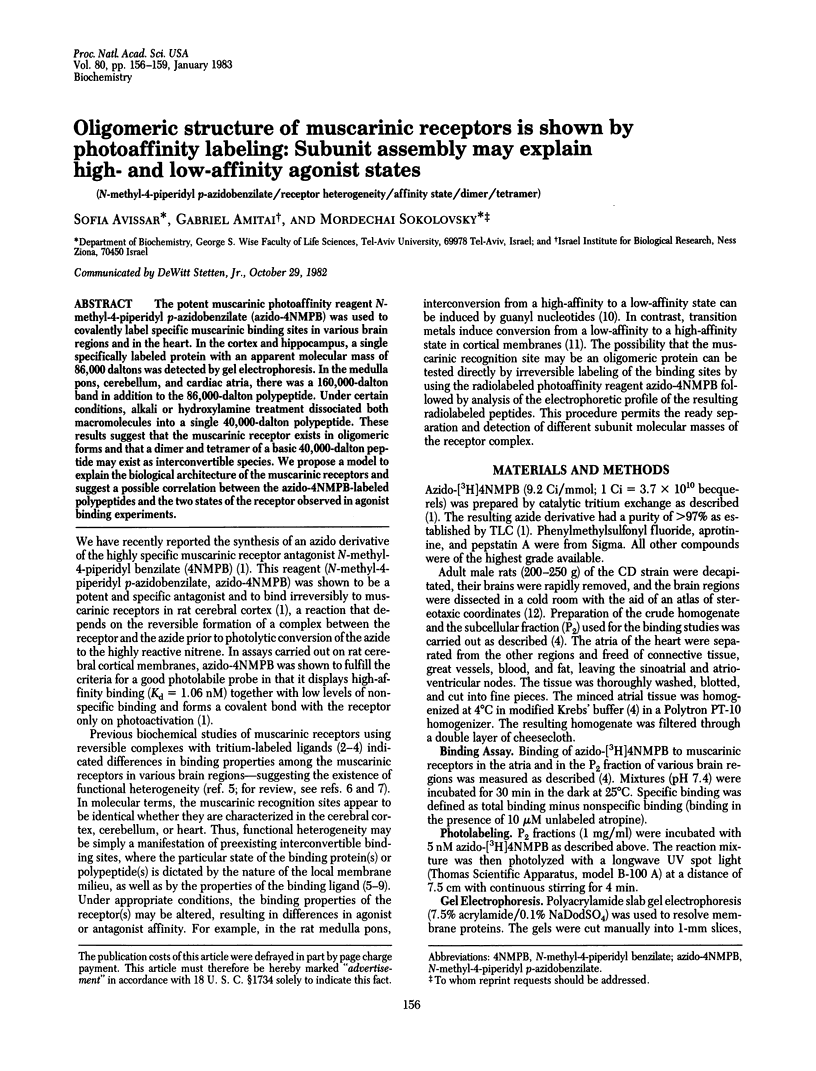Abstract
The potent muscarinic photoaffinity reagent N-methyl-4-piperidyl p-azidobenzilate (azido-4NMPB) was used to covalently label specific muscarinic binding sites in various brain regions and in the heart. In the cortex and hippocampus, a single specifically labeled protein with an apparent molecular mass of 86,000 daltons was detected by gel electrophoresis. In the medulla pons, cerebellum, and cardiac atria, there was a 160,000-dalton band in addition to the 86,000-dalton polypeptide. Under certain conditions, alkali or hydroxylamine treatment dissociated both macromolecules into a single 40,000-dalton polypeptide. These results suggest that the muscarinic receptor exists in oligomeric forms and that a dimer and tetramer of a basic 40,000-dalton peptide may exist as interconvertible species. We propose a model to explain the biological architecture of the muscarinic receptors and suggest a possible correlation between the azido-4NMPB-labeled polypeptides and the two states of the receptor observed in agonist binding experiments.
Full text
PDF



Selected References
These references are in PubMed. This may not be the complete list of references from this article.
- Amitai G., Avissar S., Balderman D., Sokolovsky M. Affinity labeling of muscarinic receptors in rat cerebral cortex with a photolabile antagonist. Proc Natl Acad Sci U S A. 1982 Jan;79(2):243–247. doi: 10.1073/pnas.79.2.243. [DOI] [PMC free article] [PubMed] [Google Scholar]
- Avissar S., Egozi Y., Sokolovsky M. Biochemical characterization and sex dimorphism of muscarinic receptors in rat adenohypophysis. Neuroendocrinology. 1981 May;32(5):303–309. doi: 10.1159/000123176. [DOI] [PubMed] [Google Scholar]
- Ben-Baruch G., Schreiber G., Sokolovsky M. Cooperativity pattern in the interaction of the antiestrogen drug clomiphene with the Muscarinic receptors. Mol Pharmacol. 1982 Mar;21(2):287–293. [PubMed] [Google Scholar]
- Birdsall N. J., Burgen A. S., Hulme E. C. The binding of agonists to brain muscarinic receptors. Mol Pharmacol. 1978 Sep;14(5):723–736. [PubMed] [Google Scholar]
- Burgoyne R. D. A possible role of synaptic-membrane protein phosphorylation in the regulation of muscarinic acetylcholine receptors. FEBS Lett. 1980 Dec 29;122(2):288–292. doi: 10.1016/0014-5793(80)80458-3. [DOI] [PubMed] [Google Scholar]
- Gurwitz D., Sokolovsky M. Agonist-specific reverse regulation of muscarinic receptors by transition metal ions and guanine nucleotides. Biochem Biophys Res Commun. 1980 Oct 16;96(3):1296–1304. doi: 10.1016/0006-291x(80)90092-3. [DOI] [PubMed] [Google Scholar]
- Hammer R., Berrie C. P., Birdsall N. J., Burgen A. S., Hulme E. C. Pirenzepine distinguishes between different subclasses of muscarinic receptors. Nature. 1980 Jan 3;283(5742):90–92. doi: 10.1038/283090a0. [DOI] [PubMed] [Google Scholar]
- Henis Y. I., Galron R., Avissar S., Sokolovsky M. Interactions between antagonist-occupied muscarinic binding sites in rat adenohypophysis. FEBS Lett. 1982 Apr 19;140(2):173–176. doi: 10.1016/0014-5793(82)80887-9. [DOI] [PubMed] [Google Scholar]
- Kloog Y., Egozi Y., Sokolovsky M. Characterization of muscarinic acetylcholine receptors from mouse brain: evidence for regional heterogeneity and isomerization. Mol Pharmacol. 1979 May;15(3):545–558. [PubMed] [Google Scholar]
- Law S. K., Lichtenberg N. A., Levine R. P. Covalent binding and hemolytic activity of complement proteins. Proc Natl Acad Sci U S A. 1980 Dec;77(12):7194–7198. doi: 10.1073/pnas.77.12.7194. [DOI] [PMC free article] [PubMed] [Google Scholar]
- Limbird L. E., Lefkowitz R. J. Agonist-induced increase in apparent beta-adrenergic receptor size. Proc Natl Acad Sci U S A. 1978 Jan;75(1):228–232. doi: 10.1073/pnas.75.1.228. [DOI] [PMC free article] [PubMed] [Google Scholar]
- Michaelson D. M., Avissar S., Kloog Y., Sokolovsky M. Mechanism of acetylcholine release: possible involvement of presynaptic muscarinic receptors in regulation of acetylcholine release and protein phosphorylation. Proc Natl Acad Sci U S A. 1979 Dec;76(12):6336–6340. doi: 10.1073/pnas.76.12.6336. [DOI] [PMC free article] [PubMed] [Google Scholar]
- Snyder S. H., Chang K. J., Kuhar M. J., Yamamura H. I. Biochemical indentification of the mammalian muscarinic cholinergic receptor. Fed Proc. 1975 Sep;34(10):1915–1921. [PubMed] [Google Scholar]
- Sokolovsky M., Egozi Y., Kloog Y. Biochemical characterization of muscarinic receptors. Monogr Neural Sci. 1980;7:30–40. doi: 10.1159/000388812. [DOI] [PubMed] [Google Scholar]
- Sokolovsky M., Gurwitz D., Galron R. Muscarinic receptor binding in mouse brain: regulation by guanine nucleotides. Biochem Biophys Res Commun. 1980 May 30;94(2):487–492. doi: 10.1016/0006-291x(80)91257-7. [DOI] [PubMed] [Google Scholar]


